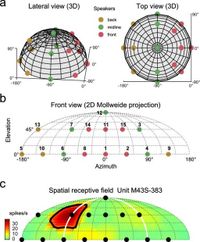A new study conducted on marmoset monkeys has shed light on a fascinating aspect of how our auditory system processes sound. Traditional understanding held that sensory neurons in the auditory cortex typically adapt to repetitive stimulation, but this research flips that notion on its head, unveiling a phenomenon known as location-specific facilitation (LSF). In stark contrast to established adaptive responses, nearly 90% of the neurons recorded in the study exhibited an increase in firing rates upon receiving repetitive sound stimulation from the same location.
This groundbreaking discovery raises intriguing questions about the underlying mechanisms of auditory perception. Instead of the expected decrease in neuronal response, the repetitive presentation of sounds resulted in long-lasting facilitation, suggesting that sensory neurons are capable of enhancing their responsiveness under specific conditions.
According to the researchers, "Instead of inducing adaptation, repetitive stimulation evoked long-lasting and location-specific facilitation (LSF) in firing rates of nearly 90% of recorded neurons." This statement encapsulates the crux of the findings, compelling scientists to reconsider how auditory contexts influence neural behavior.
Past studies on sensory adaptation often emphasized the suppression effects that influence neuronal firing rates. When the same stimulus is presented repetitively, it is not uncommon for neurons to exhibit a waning response, a phenomenon known as repetition suppression. This adaptation is well-documented in various sensory modalities, including visual and auditory systems. However, the new study reveals that, under controlled experimental conditions focusing on repetitive sound stimuli, many neurons responded instead with notable facilitation.
The researchers prepared marmoset monkeys for the experiments by using a precise array of speakers set up to deliver sounds systematically from different spatial locations. This technique allowed for a comprehensive study of how neurons react not only to repetitive sounds but also to their spatial context.
In the study's setup, sounds were played repeatedly from a designated speaker, generating sustained neuronal activation rather than the expected decline in response. This contradicts the generally accepted model of how these neurons should behave when presented with the same sound repeatedly. Instead of switching off, these neurons remained alert and reactive, showcasing an enhancement of their activity.
Utilizing computational modeling contributed to measuring the arousal levels within the auditory cortex during these experiments. The researchers concluded that increased arousal, rather than decreased inhibitory signals, is what underlies this observed location-specific facilitation. By coupling both intracellular recordings and behavioral experiments, the study establishes a dual framework for understanding auditory processing that is intimately linked to attention and sensory context.
The authors noted, "Our findings reveal a novel form of contextual modulation in the marmoset auditory cortex that may play a role in tasks such as auditory streaming and the cocktail party effect." This comment points toward the practical implications of the work, suggesting that the brains of these monkeys—and by extension, in abstractions, human brains—are adept at filtering and focusing on relevant auditory information amid potentially distracting background noise.
Understanding these dynamics not only enriches our basic comprehension of how the auditory system operates but might also inform future research focused on sensory processing disorders or model systems. If auditory neurons can maintain a heightened level of vigilance despite repetitive exposure to the same stimulus, this could open new avenues for exploring how attention is allocated and how perceptual filters are employed in more complex auditory environments, such as social interactions or bustling public spaces.
As the research community continues to unpack the implications of these findings, one theme becomes apparent: the marmoset auditory cortex serves as a vital model for advancing our understanding of sensory processing. The evidence for LSF suggests that there is an underlying adaptability to auditory perception that is far more intricate than simple response suppression.
In conclusion, this innovative study not only challenges prior assumptions based on sensory adaptation but also paves the way for further exploration of spatial and contextual effects in sensory processing. As more research tools become available, researchers will likely probe deeper into these mechanisms, unveiling even greater complexities within sensory systems.




